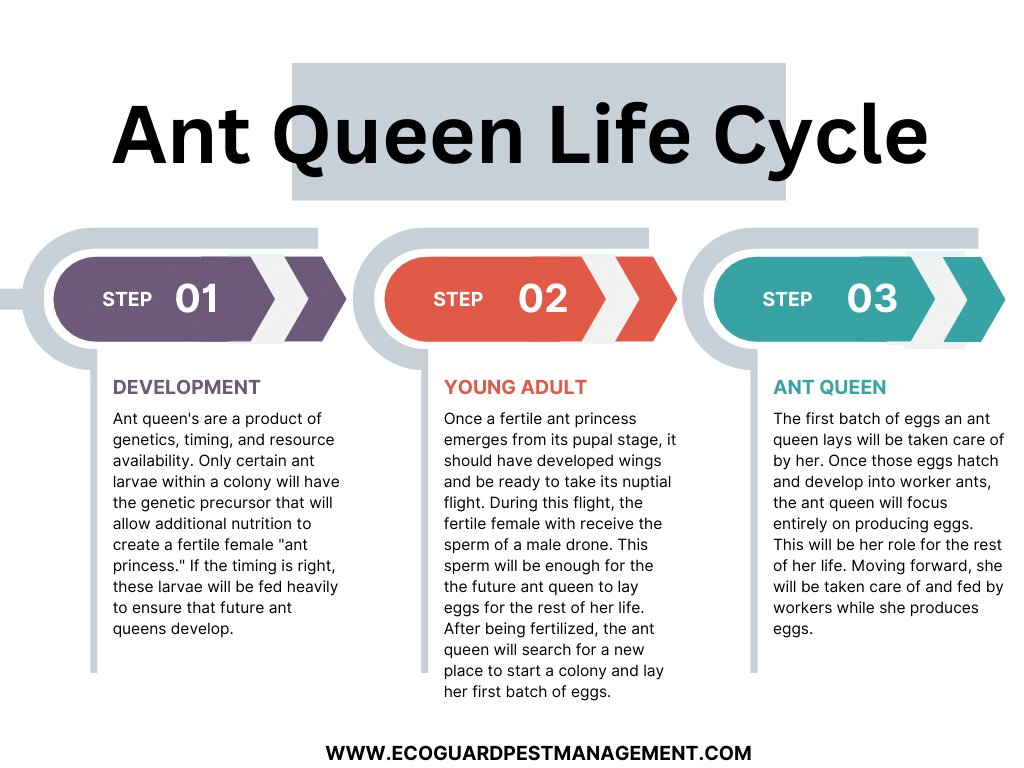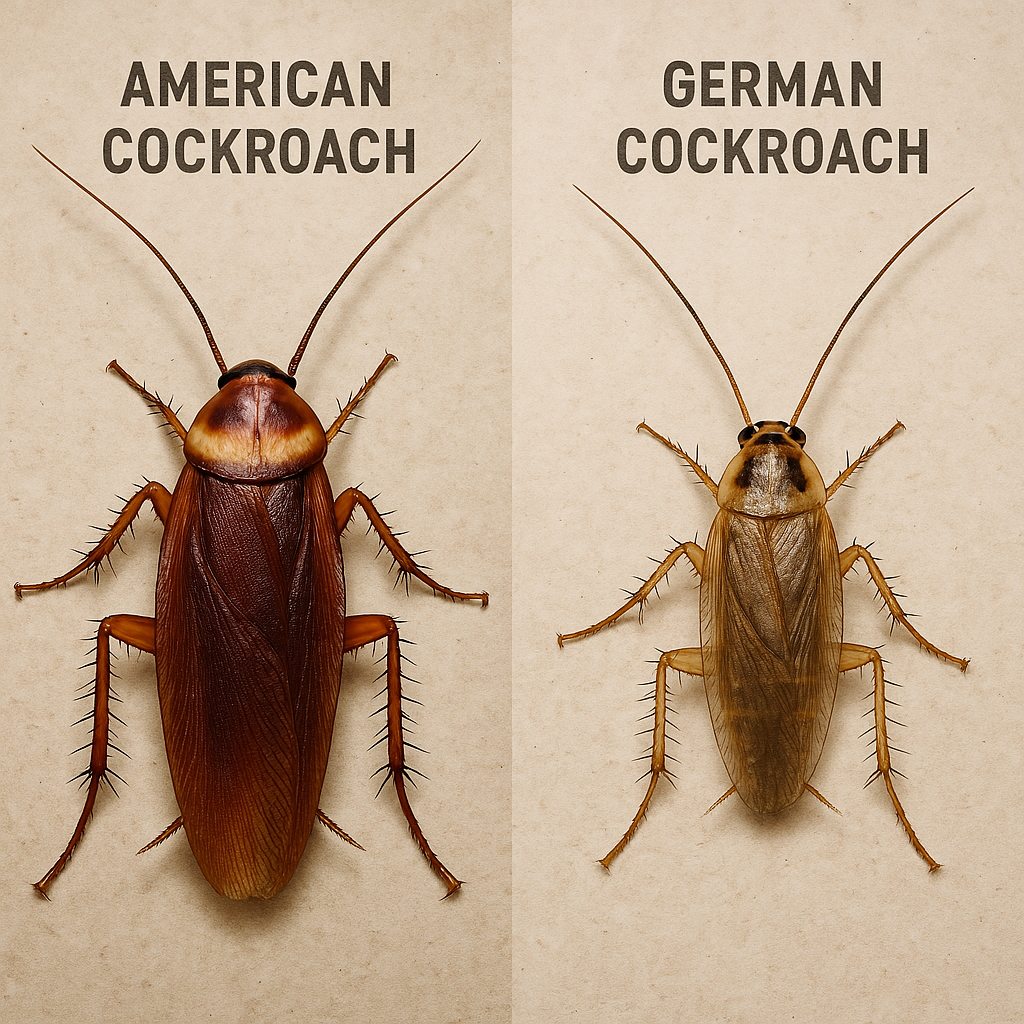What Happens When The Queen Ant Dies?
Ant colonies are usually completely dependent on a queen to survive. This is why the queens are normally the most protected colony member housed deep within a colony. They are responsible for the continuation of the ant population as well as directing how ants develop through chemical pheromone communication. When a queen is killed or dies, the likelihood of survival for most ant colonies is drastically reduced. Many species of ants won’t be able to continue egg production which means that after the remaining ants die off, the colony will collapse. Sometimes a single queen will direct her ants to create satellite colonies with other queens that can help repopulate if one queen dies.
What Does an Ant Queen Look Like?
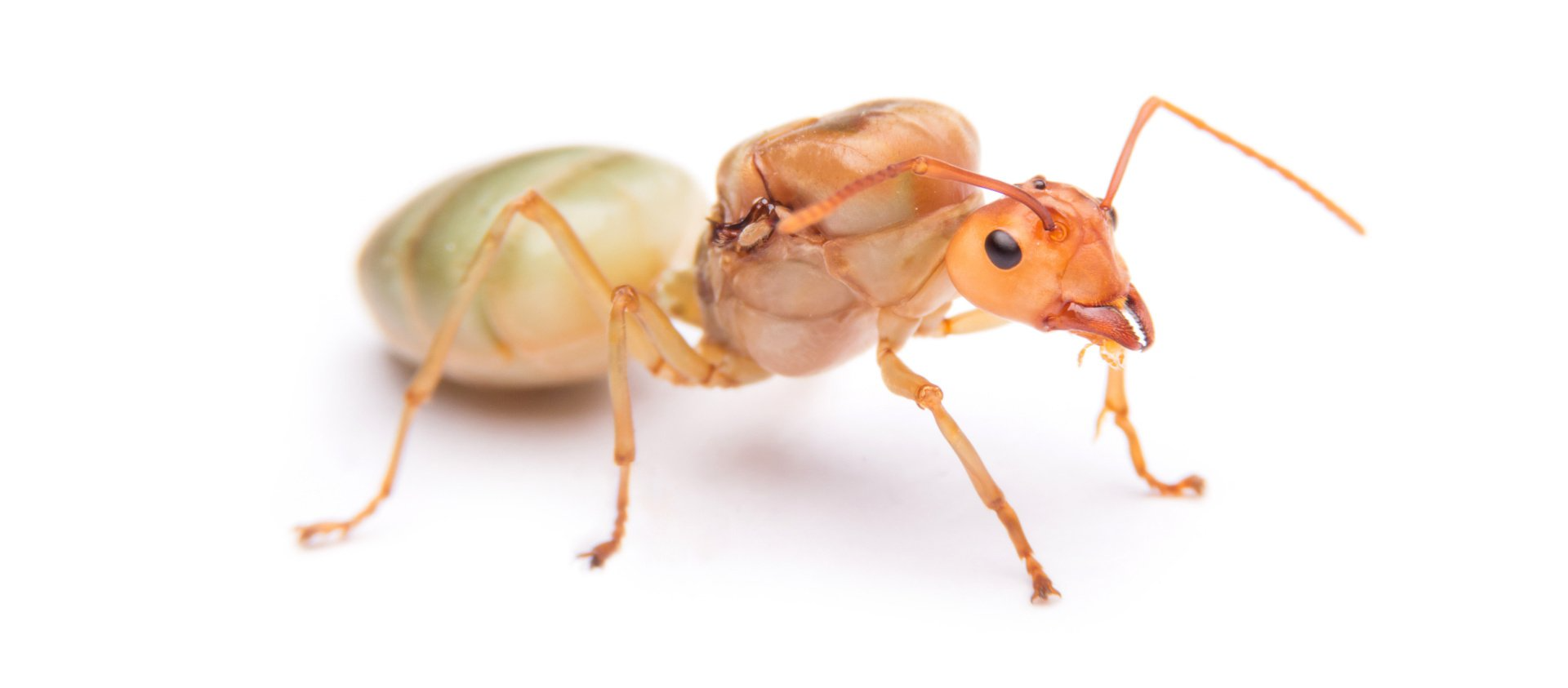
Ants pretty much all look the same, but queens are a little easier to point out. The ant queen size is usually 2 - 3x bigger than the other ants in the colony with an extremely large and engorged thorax. Ant queens are rarely seen though unless the colony has been opened up. The queen any will also be found inside or near the nest chambers where the eggs and larvae are held and taken care of. If an ant colony is exposed, the ant queen will often be swarmed by workers trying to protect the queen.
Life Cycle of an Ant Queen
Before exploring the death of an ant queen, it is important to understand their life cycle and development. Not every ant has what it takes to become an ant queen. Each stage of the life cycle helps determine if an ant will become the matriarch of their colony.
Development Stages: Larvae and Pupae
Ants in the earliest phases of their lives are helpless and rely on the rest of the colony to take care of them and ensure their survival. During the larval and pupal phases, the amount of nutrition and care they are provided will help determine an ant’s adult role. Most ants will develop into infertile female workers, especially when resources are limited. However, when resources are plentiful, a select few ant larvae will be fed better nutrients to encourage their development into fertile “ant princesses.” This occurs because the additional nutrition triggers a certain gene to develop which causes developing ants to have an insulin like protein develop in their bodies. This protein allows these ants to intake even more nutrition which helps them develop into fertile females. This gene development also causes future ant princesses to give off a pheromone that tells the other supporting ants which ant larvae to feed more. If resources are limited, the conditions are poor, or weather too cold when a fertile female larvae develops, the worker ants will identify that ant using the same pheromones and force them to revert back to a worker through stress inducing techniques like biting the larvae.
Early Adult Life
Once these ant princesses mature into adults, they develop wings and take flight. This nuptial flight typically occurs in the spring, or whenever conditions are good. The swarm will leave the colony with a group of other fertile females and male drones. This mating flight occurs for 2 reasons. During this swarm, the male drones will fulfill their role of fertilizing the ant princesses before dying off once their job is completed. This fertilization needs to occur only once and will provide the queen with enough sperm to produce eggs for the rest of their lives. The other reason is that potential female ant queens will search out a new place to create a colony. Each fertilized ant queen will find somewhere safe and then create a burrow to start laying her first batch of eggs.
Reproduction
Once the new ant queen is determined, she will start laying eggs for the new colony. This first round of eggs will become the first generation of new ant workers needed to build, expand, and care for the new ant colony. These workers are usually tended to by the queen until they are fully mature. After the new workers mature and the colony is somewhat established, the ant queen will fulfill her role and continue to just produce eggs.
Understanding the Role of the Ant Queen
The duties of the ant queen over her lifetime are to establish and maintain a new ant colony. In order to do this, her role changes from seeking out a new colony location to producing eggs to directing the development of the colony through the use of pheromones. Queen ants start off their lives as a winged alate and then leave a colony with a swarm of other male and female reproductives to mate and find a new nest location. When a new nest location is found by one of the fertilized female reproductives, she will lay her first batch of eggs. These eggs will hatch into new workers which will take over caring for the nest to allow the ant queen to focus on laying eggs. Once she reaches the egg laying phase, she is a hostage to her throne and is responsible for laying as many as several million eggs in her lifetime. After she has become the queen, her role is to sustain the colony with new workers and soldiers while providing direction for the workers who collect food for the colony.
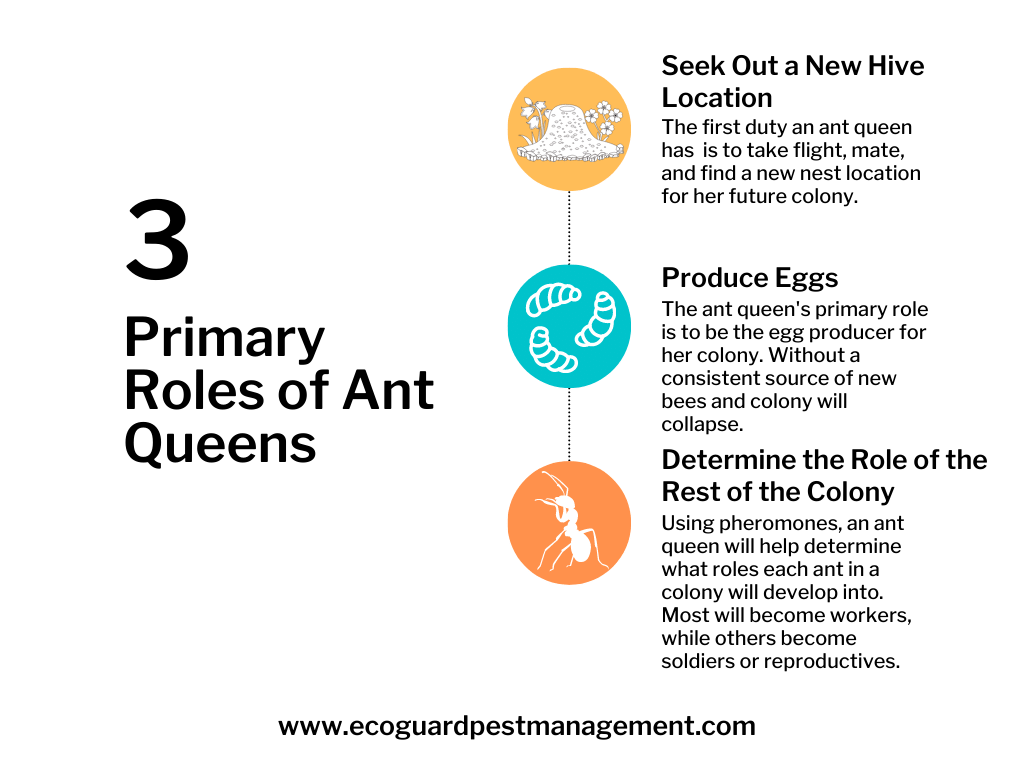
Ant Colony Hierarchy
Ant colonies have a complex hierarchy with the ant queen at the top. The rest of the ant colony is broken up into several castes, with most becoming workers. There is a worker class, soldier class, and a drone class that contribute to the operation and health of the colony. Worker ants focus on searching for and retrieving food for the ant colony since the queen, larvae, soldiers, and drones can’t feed themselves. They also expand the size of the colony. Soldier ants make up a much smaller caste whose sole purpose is to protect the ant colony against invaders like other ants and termites. The drones’ sole function is to procreate with the queen and die. The last caste would be reproductive, which are made up of fertile winged females who fly away in search of places to create new or satellite colonies. The queen ant is responsible for determining which ants are being produced to best satisfy the needs of the colony.
Can A Queen Ant Be Replaced?
In colonies that belong to species with one ant queen per colony, an ant queen can not be replaced. If she dies, the colony will continue until the remaining ants die from predators or old age. They will continue to act as if the colony is still functioning normally but without a queen, there will be no eggs or larvae to perpetuate healthy workers in a colony. In colonies that belong to species with multiple queens and satellite colonies, a younger ant queen can fill the role and repopulate the colony.
How Many Queens Can Exist in a Colony?
Several species of ants can create satellite colonies, each with their own queen. Colonies with more than one queen are known as polygyne, while colonies with one queen are monogyne. Polygyne colonies can grow so large that they become super colonies. These super ant colonies can expand over extremely large areas with the largest known super colony spanning across entire countries. The colony of Argentine ants that hold the record for largest contiguous ant colony stretches over 3,700 miles across Italy, France, and Spain. These colonies likely have thousands of queens and billions of ants, but it is impossible to tell how many queens can exist in a colony.
How Can the Queen Ant Die?
Ant queens can typically die from 1 of 4 things.
- Old age: Some species of ants can survive for up to 30 years. These ant queens will live long lives and be responsible for millions of ants in her lifetime.
- Human influence: Humans are more likely to poison or disturb a nest so badly, that the queen’s chambers are disturbed, and the queen ant is killed.
- Worker ants: Workers may cause overall colony to collapse due to returning with baits that kill the queen.
- Predators: Ants, like most living creatures, have natural predators that can dig up and expose the insides of an ant colony. When this occurs, not even soldier ants can do much to protect the queen against a much larger threat.
Ant queens are far too vital to the survival of the colony to be killed. They are rarely exposed and are kept deep within an ant nest to maximize their survival rate.
How Long Can a Colony Survive Without a Queen?
A healthy colony can survive for months without a queen. The colony will continue to live as it did with the queen, but the only problem is that egg production ceases. Without the queen, there won’t be any changes to the directives given to the worker ants so they will just continue to collect food. Without new ants to take care of, the ants will just repeat this prompt until the ant colony finally perishes from old age.
How to Kill Queen Ant
There are a couple DIY methods of treating ants that can save you some headache if you are dealing with a smaller infestation. The most common treatments include:
- Boiling water: You can pour hot water down an ant mound opening and it should flood the colony and kill everything inside.
- Ant baits: Baiting systems are effective because the workers will bring the poison back to the colony for the queen to feed on.
- Borax: This household detergent can be mixed with sugar or syrup to use as a bait for ants.
- Ant exterminator: If all other treatment attempts have failed, it is probably time to get professional help involved.
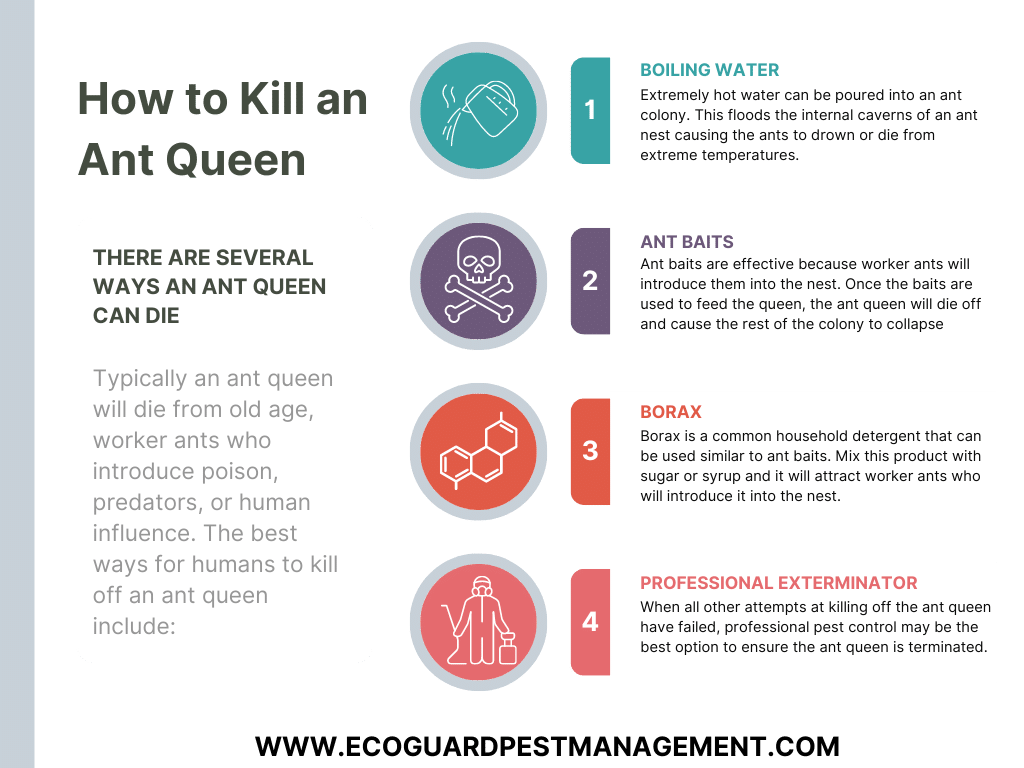
Contact EcoGuard Pest Management
If you are dealing with an ant problem that keeps coming back, it is probably because you are not able to kill the queen. Be sure to call EcoGuard Pest Management today to schedule an inspection. We know how to get rid of ants effectively and quickly. Our licensed ant control experts will identify problematic areas and provide recommendations for treatment. Our pest management team uses an integrated pest management approach to ensuring that ant populations are completely exterminated. Afterwards, we implement exclusion strategies and ant deterrents to minimize the chances that ants come back.


